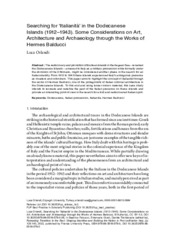Searching ‘Italianità’ in the Dodecanese Islands (1912-1943). Some considerations on Art, Architecture and Archeology through the works of Hermes Balducci
| dc.contributor.author | Orlandi, Luca | |
| dc.contributor.editor | Falcucci, B. | |
| dc.contributor.editor | Giusti, E. | |
| dc.contributor.editor | Trentacoste, D. | |
| dc.date.accessioned | 2023-03-27T06:38:52Z | |
| dc.date.available | 2023-03-27T06:38:52Z | |
| dc.date.issued | 2022 | |
| dc.identifier.isbn | 978-88-5518-579-0 | en_US |
| dc.identifier.uri | http://hdl.handle.net/10679/8087 | |
| dc.identifier.uri | https://books.fupress.com/chapter/searching-for-italianit-in-the-dodecanese-islands-19121943-some-considerations-on-art-architecture-a/11804 | |
| dc.description.abstract | The rediscovery and promotion of fourteen islands in the Aegean Sea – renamed the Dodecanese Islands – annexed to Italy as a military possession while formally under the dominion of the Ottomans, might be considered another phase in the search for an Italian identity. From 1912 to 1943 these islands experienced Italy’s ambiguous presence as invaders and colonizers. This paper aims to highlight the concept of Italianità through the works of Hermes Balducci, one of the protagonists of Italian colonial architecture in the Dodecanese Islands. To this end and using lesser-known material, this case study intends to recreate and redefine the past of the Italian presence on these islands and provide an interesting point of view in the search for a lost and rediscovered Italian spirit. For just over twenty years the islands witness the Italian presence in the Dodecanese in an ambiguous position of invaders and colonizers. From 1912 to 1923 several military governors followed one another in the civic and public administration of the islands, but after the rise of Fascism in Italy in 1922, the political attitude towards the new possessions began to change, manifesting the intention to make the islands more ‘Italian’ also through the rediscovery of historical roots that justified its annexation, at least from a cultural point of view. For thirteen years, between 1923 and 1936, the former ambassador in Rhodes, Mario Lago, held the office of Governor of the Dodecanese islands with balance, humanity and great respect for the ethnic components of the local inhabitants. Things changed radically in the following years, when the authoritarian fascist regime wanted to give the colonies a more Italian imprint. From 1936 to 1940 the governor Cesare Maria De Vecchi, count of Val Cismon administered the possessions of the Dodecanese with excessive harshness, with an almost obsessive respect for fascist ceremonial and ideology, showing very little respect for the customs, traditions and rights of Greek, Turkish and Jewish community that even under the Ottoman rule in previous centuries were always respected. At the outbreak of World War II in 1939 a new governor replaced De Vecchi until 1943, when the German Nazis took control of the islands until the end of the war. After 1945 the islands came under British military occupation for two years, before their complete return to Greece. At that time, the greatest interest for European scholars was directed to the classical age and to the rediscovery of the ‘classical’ roots of Western countries, the essence of architecture, the ancient Greek-Roman world and not to study local art and architecture. Therefore, in the name of a supposed past ‘Italianità’ of the possessions, not well identified but attributable to the period of the ancient knights of Rhodes, an architectural program of reconstructions and - based on historical remains and archaeological excavations - was carried out in all the islands of the Dodecanese and especially in the city of Rhodes. In this context, many were the architects, engineers and planners, as well as archaeologists and scholars sent by the Kingdom of Italy to study and research the past of the islands and to plan, design and rebuild these new Italian possessions. The cultural policy carried out by the Italians on the archaeological and monumental heritage had already begun between 1912 and 1913, immediately after the occupation of the islands, and continued uninterruptedly during the fascist era until the German occupation in 1943. The investments were mainly addressed to cultural activities that led to the establishment of the Italian Archaeological Mission, the realization of large excavation and restoration campaigns, the creation of museums and archaeological sites, the birth of the Superintendency of Rhodes and the FERT Historical Archaeological Institute. This paper aims to highlight the thoughts and ideas about Italianità of one of the protagonists of that colonial adventure intended to recreate and redefine the past with the Italian presence during those years. Within this purpose, the example of Hermes Balducci’s works in Rhodes and the Dodecanese Islands stands as a fundamental case study in the search for a lost and rediscovered Italian spirit. | en_US |
| dc.language.iso | eng | en_US |
| dc.publisher | Firenze University Press | en_US |
| dc.relation.ispartof | Rereading Travellers to the East: Shaping Identities and Building the Nation in Post-unification Italy | |
| dc.rights | CC0 1.0 Universal | * |
| dc.rights | openAccess | |
| dc.rights.uri | http://creativecommons.org/publicdomain/zero/1.0/ | * |
| dc.title | Searching ‘Italianità’ in the Dodecanese Islands (1912-1943). Some considerations on Art, Architecture and Archeology through the works of Hermes Balducci | en_US |
| dc.type | Book chapter | en_US |
| dc.publicationstatus | Published | en_US |
| dc.contributor.department | Özyeğin University | |
| dc.contributor.authorID | (ORCID 0000-0001-8813-0894 & YÖK ID 123282) Orlandi, Luca | |
| dc.contributor.ozuauthor | Orlandi, Luca | |
| dc.identifier.startpage | 125 | en_US |
| dc.identifier.endpage | 140 | en_US |
| dc.subject.keywords | Dodecanese | en_US |
| dc.subject.keywords | Italian possession | |
| dc.subject.keywords | Italianità | |
| dc.subject.keywords | Hermes Balducci | |
| dc.relation.publicationcategory | Book Chapter - International - Institutional Academic Staff |
Files in this item
This item appears in the following Collection(s)
Share this page




